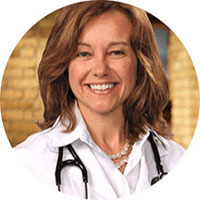Get Easy Health Digest™ in your inbox and don’t miss a thing when you subscribe today. Plus, get the free bonus report, Mother Nature’s Tips, Tricks and Remedies for Cholesterol, Blood Pressure & Blood Sugar as my way of saying welcome to the community!
What you should know about your hardworking heart valve

If I opened and closed the front door of my house 60 times a minute, it would probably fly off its hinges within a month.
But that’s exactly what our heart valves do: They open and close with every heartbeat, 60 times a minute, 60 minutes an hour, 24 hours a day (that’s nearly 90 thousand times), 7 days a week, 52 weeks a year… for 80 years (or more!)
Think of these four valves as one-way doors designed to ensure an orderly flow of blood through the heart’s chambers. The two most important valves are the mitral valve, which allows blood to flow from the lungs into the heart, and the aortic valve, which controls flow from the heart out to the body.
Although so much more resilient than hinges on a door, heart valves are not completely immune to wear and tear. Mild thickening of the aortic valve and/or a mild leak of the mitral valve are common as we age.
There are no medications for treating valve problems. The only way to fix a severely malfunctioning valve is to replace it. That’s what Mick Jagger had done a while back. And he’s not alone. Over 100,000 Americans undergo heart valve surgery each year. But there are a few things you can do to keep your heart valves in tip-top shape to avoid valve replacement.
TLC for your heart valves
High cholesterol has been shown to be associated with earlier thickening of the aortic valve. Over time, that thickening can lead to a narrowing of the valve opening called aortic stenosis. If the opening gets too narrow, blood has trouble getting out of the heart to the body, leading to various symptoms like chest pain, shortness of breath, lightheadedness and even passing out.
Once present, statins can’t reverse aortic stenosis, so exposing the valve to less LDL (bad) cholesterol over the course of a lifetime is your best bet to avoiding or delaying this type of valve problem.
And if you didn’t have a good reason to monitor and treat blood pressure before, here’s another one: A new study reveals that chronic exposure to high blood pressure also accelerates aortic and mitral valve dysfunction. For every 20-point above-normal reading of the top number, significant aortic and/or mitral valve dysfunction is about three times as likely over time.
Besides measuring and treating high blood pressure, it’s important to address why those readings are abnormal in the first place. Excess weight, inactivity, smoking, sleep apnea, stress, and a high-sodium diet all play a role. Not sure how high in sodium your diet is? Unless you cook all your foods from scratch, chances are good you’re taking in way more sodium than you think.
Ideally, we should be eating no more than 2,300 milligrams of sodium per day — that’s what’s in just one teaspoon of salt! If you have high or borderline-high blood pressure, you should be eating even less — below 1,500 milligrams per day. In tribal communities where hypertension is virtually unknown, people consume an average of 500 milligrams of sodium per day. Basically, every grain of salt we add to foods is salt we don’t need.
Food companies don’t make it easy for us to cut down on sodium. You might be shocked at how much sodium is in food — before you ever take out the saltshaker.
How to say sayonara to salt
To get serious about reducing salt intake, start looking at all food labels and online listings for the sodium content of restaurant meals. Then, replace some of the sodium-laden foods with items you know are essentially sodium-free, such as all fruits and vegetables and nearly all Step One products (the exception is our pancakes which contain baking powder to help the dough rise).
Load up on sodium-free items and you’ll naturally cut down on foods that have a higher sodium content while helping lower your cholesterol at the same time!
And here’s the best part — studies have shown that adding in fruits and vegetables while cutting back on sodium intake can yield the same results as taking a medication to lower your blood pressure.
Then you can sit back and enjoy those heartbeats, knowing your valves have been given the best chance to stay in top shape for decades to come.













